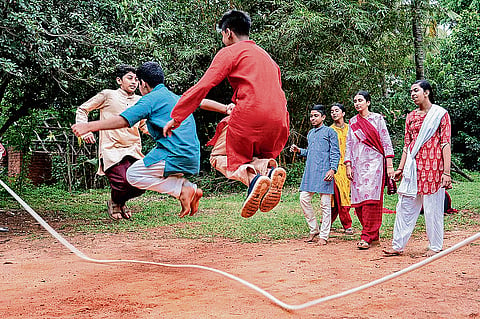

The clacking of a handloom, the smell of fresh earth, and the joy of building a treehouse are all part of how learning unfolds at Vidyakshetra, a new-age yet traditional school in Bengaluru. In its classrooms, students connect wires to voltmeters, work with pulleys, mix chemicals, weave, and build, in an effort to not learn by rote or textbooks but by experience itself.
Founded in 2016 by Muneet and Preethi Dhiman, Vidyakshetra reimagines education by combining ancient Indian values with contemporary learning. The school admits only 20 children each year from more than 900 applications, focusing not on exams but on alignment with its ethos. “We evaluate parents to see if they understand our philosophy,” says Muneet. “If the parents are too caught up in consumerism or disconnected from traditional practices, they will not fit in. They must be comfortable with the idea that their children will have no exams and no textbooks.”
A sense of community is a value that the school cherishes. All parents live within an 18-kilometre radius, and take on key responsibilities, such as managing the kitchen, transport, and administration. Some of them even collaborate on research and textbook writing. “For us as parents, there is no retirement,” says Raghavendra Poonacha, father of two students. “We become part of the school and contribute in multiple ways. A few may even start Vidyakshetras elsewhere. The idea is to redefine education with the right concepts from the past.”
The school does not charge fixed fees. “At the end of the academic year, we share next year’s budget, and parents contribute what they can. The rest comes from donations and CSR support,” says Muneet.
Vidyakshetra’s curriculum blends its own models with the National Open School system. For children aged six to 12, it follows the Panchakosha Vikas model, in which one teacher teaches all subjects, linking them together for six years. Students are introduced to 24 subjects and hands-on crafts such as weaving, pottery, knitting, and music. “We have created labs for physics, chemistry, and biology with more than 300 experiments that help children understand how things actually work,” says Muneet.
After 12, students move to the Samgr-Vikas-Vritti model until the age of 21, with individual timetables and a focus on creative, lateral thinking. “They tend to learn because they’re not under pressure of passing an examination or reading through a textbook,” says Muneet. “They can solve the same mathematics problem in three different ways because they’re not bound to a single approach.”
The results show. “Our daughter’s 94% in 12th grade, achieved with minimal cramming, proves the quality of their education,” says Pankaj Kamra, parent of Vaanya. “She is now focusing on hands-on skills like natural dyeing and handloom, a path aligned with her passion.”
The school’s roots trace back to Muneet’s personal quest. Having left a high-paying job in Germany in 2011, he returned to India seeking a deeper understanding of the Bhagavad Gita. He realised that schools here were disconnected from the realities of what India has been and what it should be. “I realised that if we don’t build relationships with our family, ourselves, and nature, we will lose our culture,” he says.
Today, the hum of looms, the earthy smell of clay, and the rhythm of young minds experimenting fill the campus. More than 39 adults are now training under Vidyakshetra to start similar schools. Here, learning is lived, felt, and built by hand — the way knowledge once was, and perhaps should be again.
The story is reported by Bindu Gopal Rao for The New Indian Express
